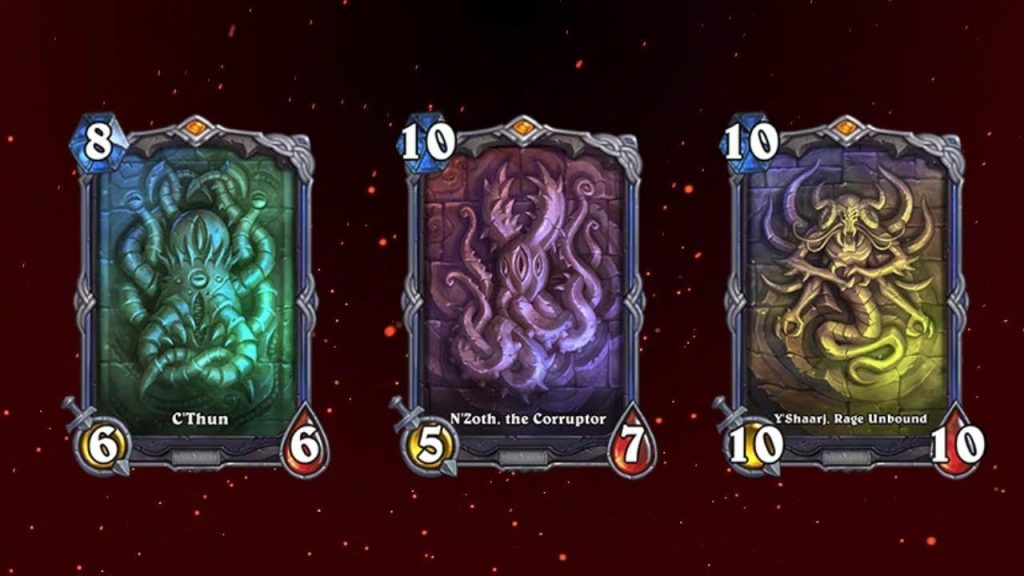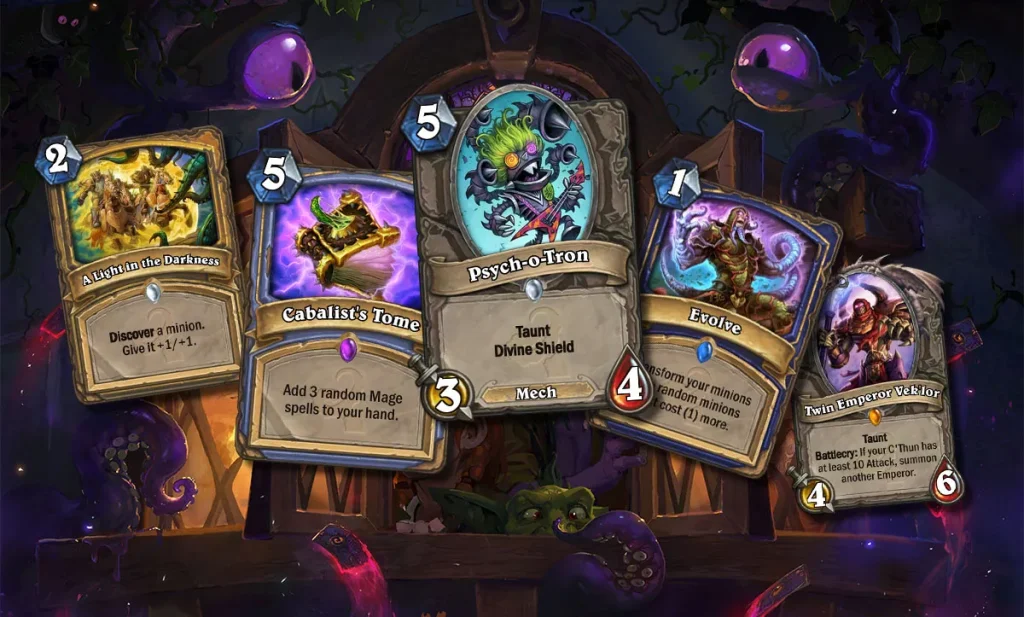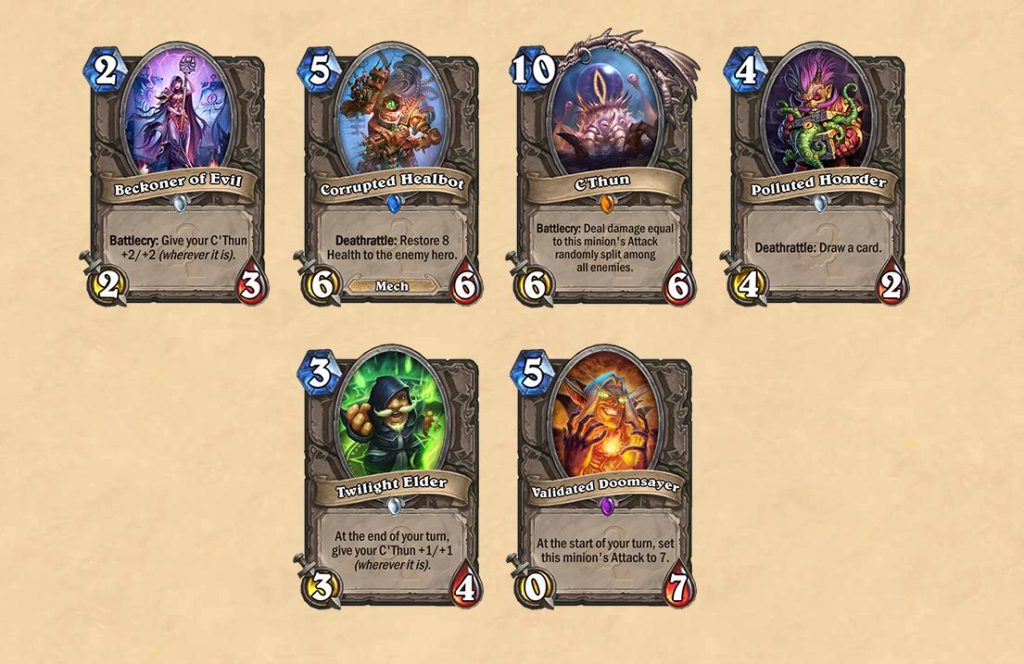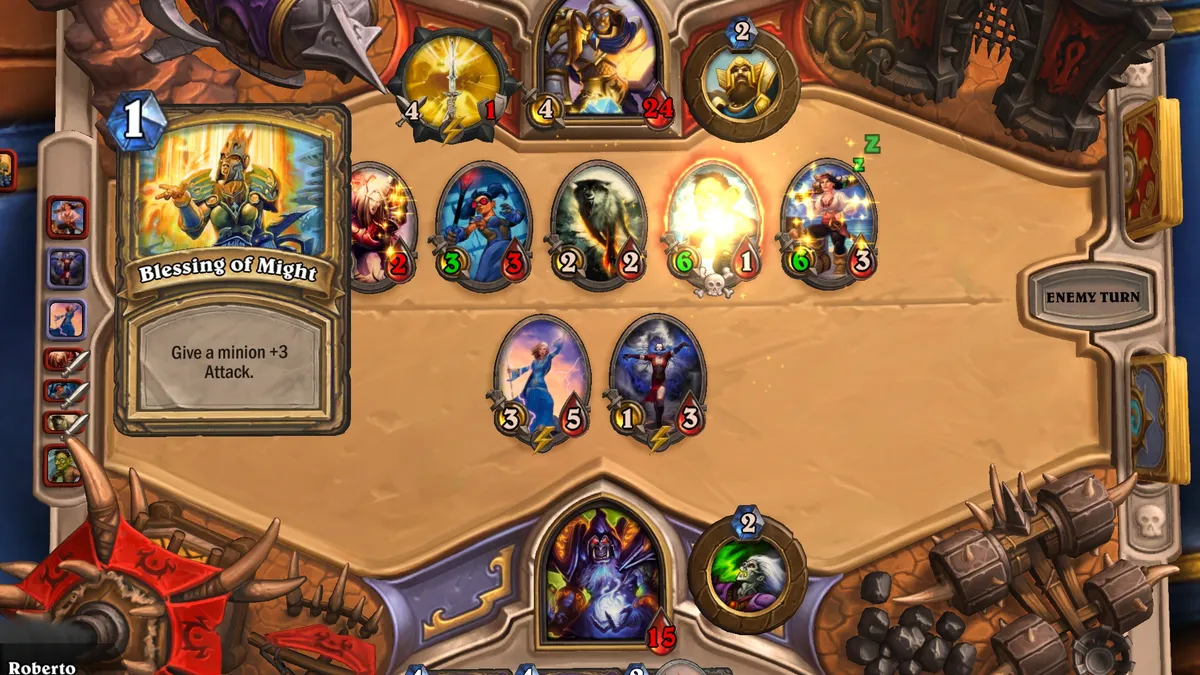Introduction
In the ever-evolving world of Hearthstone, few expansions have left as significant a mark as the one that introduced The Old Gods. This dark and mysterious theme tapped into the rich lore of Warcraft, bringing forth ancient, tentacled horrors with immense power and unpredictable influence. The Old Gods expansion, officially titled “Whispers of the Old Gods,” released in April 2016, fundamentally changed the way players viewed minion synergy, deck building, and late-game win conditions. These cosmic entities—C’Thun, N’Zoth, Yogg-Saron, and Y’Shaarj—weren’t just powerful cards; they were a thematic shift toward madness, corruption, and unpredictable outcomes that made the game more flavorful and strategically diverse. The legacy of the Old Gods continues to shape the Hearthstone meta and inspires new card designs, archetypes, and mechanics to this day. Please visit this.
Introduction Of Whispers Of The Old Gods

“Whispers of the Old Gods” was the third expansion of Hearthstone and one of its most thematically cohesive sets. This expansion introduced 134 new cards, but what made it especially memorable was its central theme of corruption and transformation. Familiar minions like Loot Hoarder and Doomsayer appeared in twisted, corrupted forms, indicating the influence of the Old Gods. Players were introduced to powerful legendary minions that represented each of the four iconic Old Gods from Warcraft lore. These gods came with mechanics that rewarded specific deck-building strategies. It was a bold creative leap, turning traditional card interactions into eldritch nightmares. The aesthetic shift to a darker, more cosmic horror tone brought a new sense of immersion and narrative depth to Hearthstone.
C’Thun: The Beginning Of Worship
C’Thun quickly became the poster child for the expansion, not just because of his card art or voice lines but due to the unique mechanic that revolved entirely around buffing him. C’Thun decks were built with a focus on synergy, utilizing cards that specifically mentioned him by name. These cards—such as Beckoner of Evil, Twilight Elder, and Disciple of C’Thun—would strengthen C’Thun’s stats while he remained in your deck. The payoff came when you finally drew and played him: C’Thun’s Battlecry would deal damage equal to his attack split randomly among all enemies. This made him a terrifying finisher, capable of wiping boards and dealing lethal damage in a single moment. C’Thun decks created a rewarding experience for players who invested in the full synergy package. It was the first time Hearthstone truly encouraged worship-like devotion to a single card, and this had a ripple effect on future expansions.
N’Zoth, The Corruptor: Resurrecting Deathrattles
While C’Thun demanded synergy through buffs, N’Zoth the Corruptor worked in another way—through the resurrection of Deathrattle minions. N’Zoth’s Battlecry effect brought back all friendly Deathrattle minions that had died during the game, creating immense value and often overwhelming opponents with a single play. This brought about a resurgence in Deathrattle-focused decks across classes like Priest, Paladin, and Rogue. N’Zoth represented inevitability. As long as you could survive long enough and play carefully, you could build a graveyard army that would return to finish the match. The card forced opponents to rethink their removal and resource management strategies, as dealing with a board full of Cairne Bloodhoofs, Sylvanas Windrunners, and Sludge Belchers not once, but twice, often proved insurmountable. N’Zoth’s impact went beyond his initial meta; he has returned in later sets and formats due to his design perfection.
Yogg-Saron, Hope’s End: Pure Chaos And Entertainment
Perhaps the most infamous and beloved Old God of the expansion was Yogg-Saron, Hope’s End. Known for its completely chaotic and often hilarious Battlecry, Yogg-Saron would cast a random spell for every spell you had cast during the game, choosing random targets for each. While completely unpredictable, the sheer entertainment value and unexpected outcomes made Yogg-Saron a community favorite. Players would build “Yogg decks” not necessarily to win but to experience the rollercoaster of results. Sometimes, Yogg-Saron would clear the enemy’s board, fill yours, draw you a full hand, and deal lethal damage all at once. Other times, he would Pyroblast your own face or cast Twisting Nether after summoning your minions. He was the embodiment of chaos and unpredictability. While Yogg was eventually nerfed to stop casting spells once he died, the card still remained a symbol of the fun and madness that Hearthstone can provide. Even now, no discussion of the Old Gods is complete without referencing the moment Yogg changed the tide of battle—sometimes in your favor, and sometimes not.
Y’Shaarj, Rage Unbound: Embracing Power
Y’Shaarj may not have seen the same level of competitive play as the other Old Gods during the expansion’s peak, but his presence was nonetheless significant. His Battlecry effect, which summoned a minion from your deck at the end of every turn, offered an ongoing value engine. In control decks, Y’Shaarj was often used to cheat out huge minions like Ragnaros or Ysera. He became a popular choice in slower Warrior or Druid builds that aimed to outlast the opponent with endless waves of massive threats. While he lacked the synergy focus of C’Thun or the impact of N’Zoth, Y’Shaarj brought his own brand of terror through consistency and inevitability. In later formats and Wild play, Y’Shaarj found a resurgence thanks to cards like Barnes and Big Recruit mechanics, where pulling massive threats from your deck early could tilt games heavily in your favor.
Cultural Impact And Community Engagement

The Old Gods expansion was not just a gameplay innovation—it was a cultural moment within the Hearthstone community. Blizzard embraced the theme fully, altering the main menu, adding eerie ambient music, and introducing card backs and emotes that reflected the whispers of corruption. Even beloved characters in the game appeared altered and sinister. The expansion became a storytelling device, drawing players deeper into a narrative that combined humor with horror. It inspired countless fan artworks, memes, YouTube videos, and tournament highlight reels, especially those featuring crazy Yogg-Saron plays. The influence of The Old Gods was deeply felt in the broader Warcraft community as well, as it linked Hearthstone back to WoW’s mythos. Players who loved the Warcraft RTS or MMORPG were thrilled to see these cosmic horrors receive new life in a different medium.
Old Gods In Wild And Returning Formats
As Hearthstone continued to expand, many players transitioned into the Wild format where all cards, including the Old Gods, remain legal. Here, the power of the Old Gods persists. C’Thun decks still exist, refined with new support cards. N’Zoth continues to headline Deathrattle control decks, particularly in Warlock and Priest builds. Yogg-Saron, especially with his unnerfed version in Wild, remains a wildcard in many spell-heavy decks. Y’Shaarj also finds use in combo decks and “Big” archetypes that aim to cheat out large threats early. Blizzard recognized the lasting appeal of these cards and occasionally reintroduces them in special events or mini-sets. The Old Gods returned in the 2020 expansion “Madness at the Darkmoon Faire,” this time with new versions that preserved their essence while adding fresh mechanics. These new versions, like “Yogg-Saron, Master of Fate” and “N’Zoth, God of the Deep,” paid homage to the original designs while keeping the meta evolving.
Deck Archetypes Centered Around The Old Gods
The presence of the Old Gods allowed for the emergence of unique deck archetypes. C’Thun decks became the foundation of many midrange and control strategies. N’Zoth-based Deathrattle decks offered some of the strongest late-game resilience in the game, allowing for deep fatigue strategies. Yogg-Saron spawned not just meme decks but also legitimate tournament-ready lists in Druid and Mage, especially during its peak. Y’Shaarj offered less consistency in competitive play but became a linchpin in greedy control decks and combo strategies. These archetypes reshaped how players viewed tempo, board control, and value generation. Suddenly, the game wasn’t just about curving out strong plays—it was about preparing the perfect moment to unleash your chosen god and flip the game in your favor.
Thematic Richness And Voice Acting
Part of what made the Old Gods unforgettable was their characterization. Blizzard invested in chilling yet charismatic voice acting for each god, giving them personality and presence. C’Thun’s whisper of “Your nightmare begins” became an instant classic. N’Zoth’s guttural murmurs, Yogg’s laughter, and Y’Shaarj’s angry proclamations made every play memorable. Their quotes became memes, soundboards, and rallying cries for fans. The cards didn’t just perform well—they were iconic. The theming around the cards—from their visual designs to their animations—gave players the sense that they weren’t just playing Hearthstone, they were participating in a grand, cosmic event. This kind of immersive design has been a benchmark for all subsequent expansions.
Madness At The Darkmoon Faire And The Return Of The Old Gods
In 2020, Blizzard reignited the flame with “Madness at the Darkmoon Faire,” which brought new versions of the Old Gods. These reimagined cards offered new mechanics but the same aura of dread and excitement. C’Thun was now shattered into pieces that had to be assembled during the game, adding a puzzle-like feel to his invocation. Yogg-Saron, Master of Fate introduced a Wheel of Fate mechanic, offering random yet powerful effects. N’Zoth, God of the Deep now resurrected minions of different minion types, reflecting the growing tribal themes in the game. Y’Shaarj offered value from Corrupt cards. These cards fit well into the modern Hearthstone meta while keeping the spirit of their ancestors alive. It was proof of the Old Gods’ eternal relevance and adaptability in the game’s design philosophy.
Competitive Impact And Meta Shaping

The Old Gods left a heavy imprint on competitive Hearthstone. In multiple tournaments following their release, C’Thun decks dominated lineups due to their consistency and predictability. Players could craft game plans around reaching 10 mana and unleashing C’Thun for maximum effect. N’Zoth provided values that few control decks could match. Even when Yogg-Saron was viewed as “uncompetitive,” he still appeared in major tournaments simply due to the possibility of flipping games with one card. The impact of these cards went beyond casual play—they forced professional players to adapt. Control matchups became more about resource management and fatigue. Midrange decks had to consider inevitability and whether they could kill the opponent before their god arrived. It changed the rules of engagement and elevated Hearthstone’s strategic ceiling.
Conclusion
The Old Gods are more than just legendary cards in Hearthstone—they are living embodiments of the game’s creativity, complexity, and capacity for chaos. They brought an era of strategic innovation, thematic storytelling, and wild gameplay moments. Whether it was C’Thun’s crescendo of power, N’Zoth’s graveyard revival, Yogg-Saron’s unpredictable spellstorm, or Y’Shaarj’s relentless minion pull, each god left an unforgettable impression. As Hearthstone continues to grow and shift, the echoes of these ancient beings still whisper through its meta, its mechanics, and its player base. The Old Gods expanded the boundaries of what digital card games could be, merging storytelling with strategy in a way few games have accomplished. For many, their introduction marked a golden era in Hearthstone—a time when madness ruled, and fun was only a draw away.

